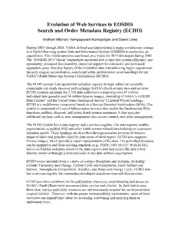
NASA Technical Reports Server (NTRS) 20090005948: Evolution of Web Services in EOSDIS: Search and Order Metadata Registry (ECHO) PDF
Preview NASA Technical Reports Server (NTRS) 20090005948: Evolution of Web Services in EOSDIS: Search and Order Metadata Registry (ECHO)
Evolution of Web Services in EOSDIS Search and Order Metadata Registry (ECHO) Andrew Mitchell, Hampapuram Ramapriyan and Dawn Lowe During 2005 through 2008, NASA defined and implemented a major evolutionary change in it Earth Observing system Data and Information System (EOSDIS) to modernize its capabilities. This implementation was based on a vision for 2015 developed during 2005. The “EOSDIS 2015 Vision” emphasizes increased end-to-end data system efficiency and operability; increased data usability; improved support for end users; and decreased operations costs. One key feature of the Evolution plan was achieving higher operational maturity (ingest, reconciliation, search and order, performance, error handling) for the NASA’s Earth Observing System Clearinghouse (ECHO). The ECHO system is an operational metadata registry through which the scientific community can easily discover and exchange NASA’s Earth science data and services. ECHO contains metadata for 2,726 data collections comprising over 87 million individual data granules and 34 million browse images, consisting of NASA’s EOSDIS Data Centers’ and the United States Geological Survey’s Landsat Project holdings. ECHO is a middleware component based on a Service Oriented Architecture (SOA). The system is comprised of a set of infrastructure services that enable the fundamental SOA functions: publish, discover, and access Earth science resources. It also provides additional services such as user management, data access control, and order management. The ECHO system has a data registry and a services registry. The data registry enables organizations to publish EOS and other Earth-science related data holdings to a common metadata model. These holdings are described through metadata in terms of datasets (types of data) and granules (specific data items of those types). ECHO also supports browse images, which provide a visual representation of the data. The published metadata can be mapped to and from existing standards (e.g., FGDC, ISO 19115). With ECHO, users can find the metadata stored in the data registry and then access the data either directly online or through a brokered order to the data archive organization. ECHO stores metadata from a variety of science disciplines and domains, including Climate Variability and Change, Carbon Cycle and Ecosystems, Earth Surface and Interior, Atmospheric Composition, Weather, and Water and Energy Cycle. ECHO also has a services registry for community-developed search services and data services. ECHO provides a platform for the publication, discovery, understanding and access to NASA’s Earth Observation resources (data, service and clients). In their native state, these data, service and client resources are not necessarily targeted for use beyond their original mission. However, with the proper interoperability mechanisms, users of these resources can expand their value, by accessing, combining and applying them in unforeseen ways. ECHO provides access to its capabilities through a set of services. These ECHO Applications Program Interfaces (APIs) are based on industry standards for performing web-based computing, specifically web services profile. The Web Services (WS) based interface was introduced to ECHO using WS APIs with the release of version 8 in October 2006. In determining this path forward, the impact of this change was initially assessed with our partner representatives and was also brought forward for comments and discussion at the technical community meetings. While there was some external impact, it was assessed that this was the best path forward for ECHO and EOSDIS Evolution activities. While the WS interface was easier to work with than the legacy XML, the legacy XML interface existed in parallel with the new WS API until the release of ECHO 9 in April 2007 after which only the WS API was retained. The service interfaces are defined using Web Services Definition Language (WSDL). Access to the services is through the Simple Object Access Protocol (SOAP). The ECHO service registry conforms to the Universal Description and Discovery and Integration (UDDI) and leverages the ISO 19119 standard for service categorization. Examples of data services in ECHO include subsetting, data reformatting, and search services such as a thesaurus. Users can search, manage, and access the contents of ECHO’s data and services registries through user-developed and community-tailored interfaces or clients. Introducing this WS API based on industry standards has helped support broad, external client development in the ECHO system. Scientists and engineers can build interfaces using ECHO’s publicly available APIs or existing ECHO client components. Using these standards, clients written in most contemporary programming languages are isolated from the underlying technologies that support the distributed communication and functionality. These clients may call the ECHO Web Services much like a local function call. EOSDIS’s move to incorporate Web Services standards has increased client development in the ECHO system by reducing the complexity of integration and delivering platform and technology independence. ECHO currently has 3 operational clients including one built by the European Space Agency (ESA) and 3 clients under development. Web Services’ broad applicability reduces the number of tools needed while leveraging Internet protocols and infrastructure. Most current developer tools support these standard technologies (e.g., WSDL, SOAP, WS-I Basic Profile 1.0) natively. EOSDIS’s multi- organizational content in ECHO, the use of Web Service technology and a Service Oriented Architecture (SOA) provides a valuable service to a growing number of Earth science applications and interdisciplinary research efforts.
